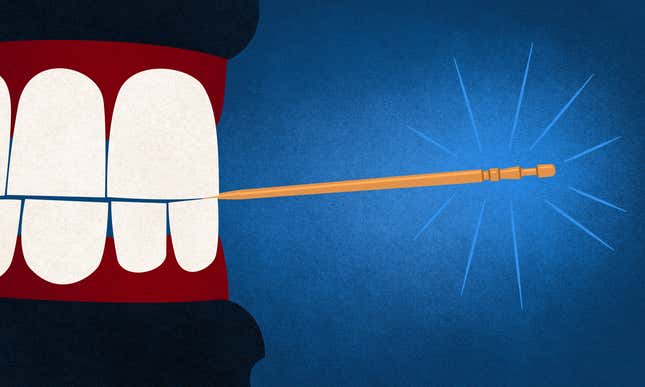
The summer I was nine, I learned how to brush my teeth with a twig. My grandpa handed me a small piece broken off what’s called a neem tree, and told me to chew on it. I was hit by a very vegetal bitterness, the kind that puckers your mouth by sheer force of personality, crowding out all the other flavors there. But I was in India and getting used to unfamiliar tastes, like chili and turmeric and tamarind, so I played along. With my molars, I mashed the end until the wood fibers splayed out into a kind of brush. Then I got to scrubbing my teeth and tongue, neem-spit and twig replacing Crest and Oral-B. When I was done, my mouth felt like it had been purified by some ornery but benevolent old tree spirit.
I haven’t chewed on neem since, but this memory resurfaced recently when I got to the counter of my local bodega and found, in the sacred space dedicated to high-margin, pocket-sized impulse buys, a pack of Auromere Neem Picks. I’d never spent money on toothpicks in my life, preferring instead to grab a few on my way out of Chinese restaurants and entomb them unused in my more obscure jacket pockets. I rarely, if ever, craved one. But with neem in mind, I bought them anyway.
The toothpick occupies two specific niches in my mind: either a corny affectation or an unglamorous utensil. You can find it dangling off some brooding protagonist’s lip in lieu of cigarette. Or you find it in between your dad’s teeth, dislodging stringy shrimp bits, tossed away as soon as the excavation’s complete. In between these poles, I saw no place for the casual enthusiast who wants to enjoy a leisurely teeth-cleansing, maybe even in public, without signaling anything in particular. Even as I pocketed the pack, I was unsure when and where I would use these things.
My first few toothpickings were unexceptional, methodical, bland. But the trick, I soon learned, is not just to quickly pick and discard, but to let them marinate for a little, nibbling occasionally on them, letting the oils slowly diffuse through your mouth juice. I could taste a tinge of neem’s purifying bitterness, but it was tempered by the sweetness of peppermint, spearmint, cinnamon.
What these picks did for me was fill the void of transit. Anytime I was getting from point A to point B, I could turn to a mouth-satisfying habit that didn’t forecast oral cancer and wouldn’t turn my belly into a graveyard for gumwads, per childhood myth. (I’ve since had this debunked, but even after all those years, I can’t entirely shake that haunting image.) It also offered some respite after particularly offensive meals involving raw onions, anchovies, or garlic—or my favorite forms of pizza, which involve all three. I cannot identify with the hygienic sociopaths who brush their teeth after each and every food consumption, but I do now carry in my pocket a slender solution for those occasional cravings of freshness.
The product has brightened my breath, and life in general, but is not without a crippling flaw: its fickle lid, prone to pop open at inopportune times. Deep in a pants pocket, the lid often popped open to release a horde of picks that dig into my thigh like a multi-pronged bee sting. And when a friend grabbed the closed box a little overzealously, the lid flew open and the picks showered across the concrete, a game of pick-up sticks no one would play, well aware that a subway station is an exception to my or anyone’s five-second rule.
But most of my attempts at sharing these have been successful. The picks are packaged cleverly: business-side pointing down, the other side lightly grooved so you can pluck them out one at a time with your nails. Pop open a pack at a party, and after a little teasing, people are surprisingly willing to try. And you get 100 per pack, which lasted me many subway sojourns and social gatherings. (I’ve since bought a 12-pack on Amazon, so there are over a thousand minty sticks chilling in my apartment as we speak.)
I skew skeptical when it comes to slickly packaging ordinary Indian things—see yoga, incense, ghee, etc.—and peddling them to the gentrifying masses, but this felt less like cultural appropriation and more like broadening the appeal of a very slept-on, very good tree. Ordinarily I would be too embarrassed to share my luxury purchases with my mother, who raised me to spend money prudently. But I couldn’t help myself. I texted her a photo of the box. She said it triggered in her an image of her father walking from the farm to the house, chewing a neem stick, walking tall, holding his veshti in one hand. “His morning ritual when I was young,” she said. And my everyday ritual now.
Lead art by Jim Cooke.